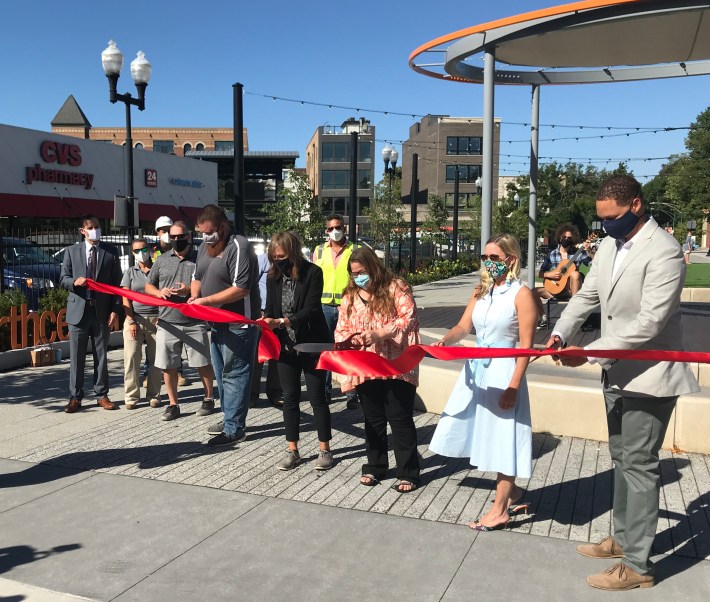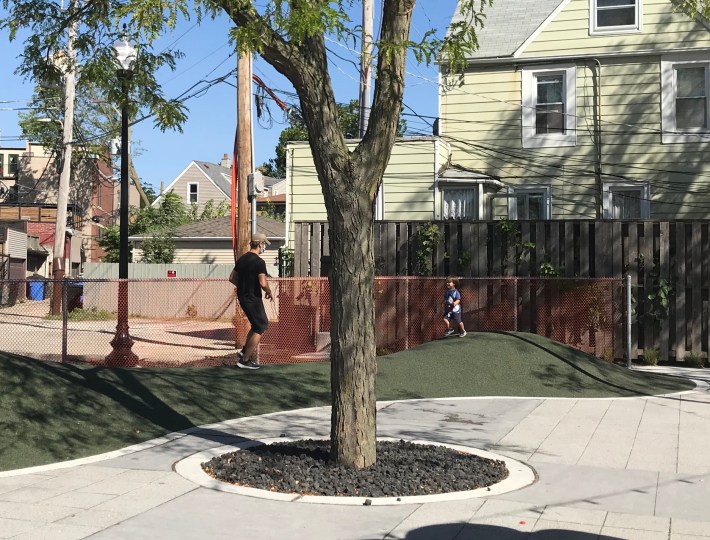Great things happen when you take space away from cars and give it to people.
Northcenter Town Square, Chicago's newest public space at Belle Plaine and Damen avenues, is an excellent example of that principle. While the design isn't perfect -- more on that later -- it took land that was mostly used for storing privately owned metal boxes and turned it into a wonderful neighborhood amenity for everyone from kids to seniors.

While there's been a small plaza at this location for many years, this project roughly doubled its size by pedestrianizing the cul-de-sac-ed block of Belle Plaine between Lincoln and Damen avenues, a street segment that basically had no purpose except for housing a dozen or so metered parking spots. In additional to providing more space for farmers markets and other special events, the $2 million street remix made room for a stage with an overhead canopy, cafe seating, and Astroturfed areas for for play and sunbathing.
City officials and community leaders cut the ribbon on the town square this morning. Chicago Department of Transportation commissioner Gia Biagi noted at the event that the new space is "just the kind of place we need right now," during the pandemic, a time when it's wiser for residents to gather in outdoor public spaces than indoor ones, and people are seeking safe ways to recreate and connect with their friends and neighbors.

Biagi added that the plaza redesign joins the Leland Slow Street (the city calls it a "Shared Street") as an example of a successful COVID-era livable streets initiative in the 47th Ward. Slow Street treatments involve banning through traffic on residential roadways to make room for safe, socially-distanced walking and biking, and Leland was the first and perhaps the most popular of these corridors. She said more than ten miles of Slow Streets have been implemented citywide. Biagi also touted the city's Cafe Streets program, which has pedestrianized restaurant strips to facilitate outdoor dining, with more than 300 restaurants participating.
Planning for Northcenter Town Square began in 2017 under then-alderman Ameya Pawar, who stepped the following year, working with the Northcenter Chamber. At the ribbon-cutting current alderman Matt Martin thanked Pawar for getting the ball rolling, and heralded the plaza as a crucial neighborhood resource. "In these times of anxiety, our neighbors feel an increased need for public space for pedestrians to spend time outside in a socially distanced manner," Martin said in a statement.

The original concept for the new space was brainstormed by Port, an urban design firm, and Civiltech did the design engineering. The Northcenter Special Service Area (SSA #38) will be responsible for maintaining the town square.
Typically when metered sparking paces are eliminated for a livable streets project, the city is required to compensated the parking concessionaire, usually by creating new paid spots elsewhere in the ward. CDOT and 47th Ward staffers at the event were unsure exactly what deal was worked out. Martin said there seems to have been relatively little pushback from merchants and residents to the loss of the parking spots on Belle Plaine, since people were already accustomed to the block being pedestrianized for farmers markets and the annual North Center Rib Fest.

The main downside of the new design is that while there's plenty of Astroturf, it created little or no natural green space, and it feels like something of a heat island on a warm day. Martin said that residents wanted a space that would be useful year-round and easy to maintain, and he noted that the space will get greener and shadier as newly-planted trees mature. (It appears that some older trees were cut down as part of the project.) He added that the artificial turf and new pavers are more permeable than the asphalt that previously occupied the land.
But the current lack of greenery is a relatively minor issue in light of the major benefits this project brings to the community. It would be great to see more of these kinds of parking-to-public-space transformations elsewhere in the city, especially in underserved communities on the South and West sides that have less than their fair share of plazas and parkland.




